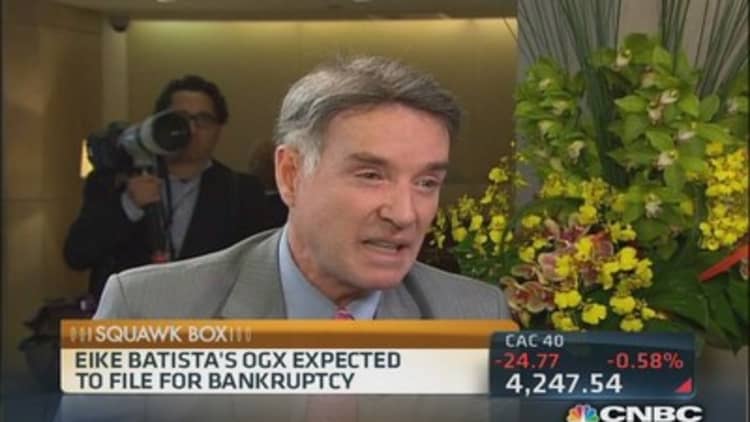
Eike Batista is quickly becoming the poster boy for the new age of high-beta wealth.
The Brazilian oil tycoon—who didn't have much oil, as it turned out—has seen his fortune drop from an estimated $34 billion to under $1 billion in a year and a half. The shares in his various companies have crashed and his main company, oil and gas driller OGX, could file for bankruptcy in the coming days.
Batista declared in 2011 that he would soon become the richest man in the world. Instead, he's closing in on a different wealth record: the largest personal-wealth loss in the world.
There are different ways of measuring wealth losses, of course. You can measure it in dollar terms or percentage terms.
(Read more: Eike Batista: The downfall of a $30 billion tycoon)
In pure dollar terms, there are others who have lost more paper wealth than Batista. In 1999, when Microsoft stock plunged, Bill Gates saw his fortune fall by nearly $40 billion. But he still had around $60 billion left.
Sheldon Adelson also comes close. The gaming magnate saw his investments decline by around $30 billion in 2008, chopping off 93 percent of his paper wealth. He had to lend his company, Las Vegas Sands, $1 billion of his own cash to keep it going. But when the stock recovered, so did Adelson.
Overseas, Lakshmi Mittal is also a top wealth loser. The Indian steel tycoon racked up a paper wealth loss of around $32 billion during the financial crisis. But he too rebounded fairly quickly with global stock markets.
(Read more: Ultimate Hilfiger accessory: His $80 million condo)
So what about percentage terms? Again, there is at least one billionaire who has out-lost Batista. Sean Quinn, the Irish property developer, went from a net worth of around $6 billion (and the title of Ireland's richest man) to bankruptcy in just a few short years. At least Batista could have a few hundred million left.
Still, there are no other recent examples of a billionaire going from $34 billion to under $1 billion in a little over a year. And it's still not over. It remains to be seen what Batista's personal assets will be once the corporate debts are settled. He's put his private jets up for sale and his holding company's yacht, the Spirit of Brazil VII, might also be on the market.
Batista is being called many things: a symbol of Brazil's false promise, the latest mirage in the global oil boom, a tragic figure felled by hubris and overreach.
(Read more: Wealthy could lose big if Fed stops money flow)
But most of all, Batista is the crowning example of our new era of the high-beta rich. As I describe in my book of the same name, today's wealth is sudden—suddenly made and suddenly lost.
Rather than relying on steady business profits that trickle in over decades and even generations, today's wealthy make their windfalls from financial flash floods, with hot money from around the world chasing a winning person or idea. Even if most of today's wealthy don't have collapses as extreme as Batista's, wealth around the world is far more volatile and prone to bigger wealth swings—i.e., a "higher beta"—than the rest of the population.
The gains for today's high-beta rich can be huge and instant. But when fortunes are built on paper, they can just as quickly go up in smoke.
Batista may be the biggest loser today. But he won't be the last—and he probably won't remain the biggest.
—By CNBC's Robert Frank. Follow him on Twitter @robtfrank.
Watch "Secret Lives of the Super Rich," an all-new series airing Wednesdays at 9 p.m. ET/PT. http://superrich.cnbc.com


